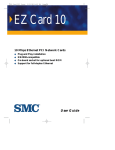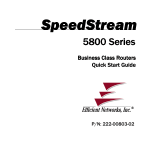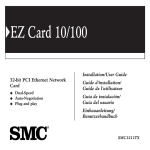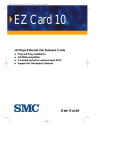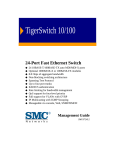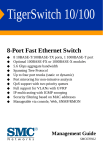Download EliteView
Transcript
EliteView The easy way to manage your network SNMP-Based Network Management Software for Windows TM Managing SMC’s TigerSwitch™ 100 User Guide ELITEVIEW™ NETWORK MANAGEMENT SOFTWARE MANAGING SMC’S TIGERSWITCH™ 100 SMC6608T SMC6608M SMC 350 Kennedy Drive Hauppauge, New York 11788 Publication 900.10908, Rev. B Information furnished by SMC Networks, Inc. (SMC) is believed to be accurate and reliable. However, no responsibility is assumed by SMC for its use, nor for any infringements of patents or other rights of third parties which may result from its use. No license is granted by implication or otherwise under any patent or patent rights of SMC. SMC reserves the right to change specifications at any time without notice. Copyright © 1998 by SMC Networks, Inc. Hauppauge, New York. All rights reserved. Printed in U.S.A. Trademarks: SMC is a registered trademark; and TigerSwitch, EliteView and EliteFax are trademarks of SMC Networks, Inc. Other product and company names are trademarks or registered trademarks of their respective holders. CONTENTS Introduction .......................................................................................................................1 Accessing the TigerSwitch 100 .........................................................................................2 Accessing TigerSwitch 100 Summary Screens..........................................................3 TigerSwitch 100 Front Panel Description ..................................................................3 Switch Summary................................................................................................................6 Accessing the Switch Summary .................................................................................6 Switch Summary Guidelines ......................................................................................7 Modifying Switch Summary parameter fields ....................................................7 Switch Statistics.................................................................................................................9 Accessing Switch Statistics ........................................................................................9 Switch Statistics Guidelines .......................................................................................10 Modifying Switch Statistics parameter fields .....................................................10 IP Statistics ........................................................................................................................11 Accessing IP Statistics................................................................................................11 IP Statistics Guidelines...............................................................................................12 Modifying IP Statistics parameter fields.............................................................12 Corresponding MIB Variables ............................................................................13 SNMP Statistics.................................................................................................................14 Accessing SNMP Statistics ........................................................................................14 SNMP Statistics Guidelines .......................................................................................15 Modifying SNMP Statistics parameter fields .....................................................15 Corresponding MIB Variables ............................................................................16 ICMP Statistics ..................................................................................................................17 Accessing ICMP Statistics .........................................................................................17 ICMP Statistics Guidelines ........................................................................................18 Modifying ICMP Statistics parameter fields.......................................................18 Corresponding MIB Variables ............................................................................19 i CONTENTS Health Statistics .................................................................................................................20 Accessing Health Statistics ........................................................................................20 Health Statistics Guidelines........................................................................................21 Modifying Health Statistics parameter fields......................................................21 Corresponding MIB II Variables ........................................................................22 Spanning Tree....................................................................................................................23 Accessing Spanning Tree ...........................................................................................23 Spanning Tree Guidelines ..........................................................................................24 Modifying Spanning Tree parameters.................................................................24 VLAN Groups ...................................................................................................................25 Accessing VLAN Groups...........................................................................................25 VLAN Groups Guidelines..........................................................................................26 Modifying VLAN Groups...................................................................................26 Port Summary ....................................................................................................................27 Accessing Port Summary ...........................................................................................28 Port Summary Guidelines ..........................................................................................28 Modifying Port Summary parameter fields.........................................................28 Port Statistics .....................................................................................................................30 Accessing Port Statistics ............................................................................................30 Port Statistics Guidelines............................................................................................31 Modifying Port Statistics parameter fields..........................................................31 Configuring Traps..............................................................................................................32 Accessing Trap Configuration....................................................................................32 Trap Configuration Guidelines...................................................................................32 Modifying Trap Configuration parameter fields.................................................33 Index ..................................................................................................................................I-1 ii Introduction SMC’s TigerSwitch 100 units are high-performance, Fast Ethernet switches that are perfect for high-traffic environments. Depending on the model, the TigerSwitch 100 features either 8 fixed 100BASE-TX ports with Auto-Negotiation (automatic selection of data rate and operating mode based on attached device) or various combinations of 100BASE-TX and 100BASE-FX ports distributed among two 4-port replaceable modules. An SNMP Agent is also included so that SMC’s EliteView or other SNMP-based management applications can collect and display status and performance information about the switch and perform needed configuration and control functions. Supported TigerSwitch 100 models include: • SMC6608T • SMC6608M Some of the real-time management functions that EliteView allows you to perform for the TigerSwitch 100 include: • Viewing Status LEDs • Viewing Switch Summary and Statistics • Viewing a Port Summary and Port Statistics • Obtaining performance statistics for IP, SNMP and ICMP protocols • Configuring and viewing statistics for the Spanning Tree Protocol (STP) • Configuring trap tables • VLAN Groups Refer to your TigerSwitch 100 documentation for a full description of the TigerSwitch 100 switch and the MIB variables used to manage it. Note: For general instructions about how to install and use EliteView, refer to the EliteView User Guide. 1 MANAGING SMC’S TIGERSWITCH 100 Accessing the TigerSwitch 100 On the Subnet map, double-click the TigerSwitch 100 icon representing the switch you wish to manage. Note: You can also select a TigerSwitch 100 from the Node list, or you may use the pull-down menus. Under Object, choose Manage Device, click on IP and enter the IP address of the switch you wish to manage. A zoomed-in graphic of the front-panel of the TigerSwitch 100 unit you are accessing, similar to one of those illustrated below, will appear showing the node address and location. The front panel LEDs are also displayed (Refer to the TigerSwitch 100 user guide for a complete description of the front panel LEDs). SMC6608T 1 2 SMC6608M 2 SMC6600T SMC6600F SMC6600FSCT SMC6600FSTT MANAGING SMC’S TIGERSWITCH 100 Accessing TigerSwitch 100 Summary Screens The diagrams on the previous page represent the front-panels of the two TigerSwitch 100 units. Please note that the front-panel representation of the TigerSwitch 100M (SMC6608M) is dependent upon the module(s) installed in the switch. Any one (or two) of the modules shown below the graphic will appear as part of the graphic (in the general area marked by the arrows), if installed in the switch. Switch and Port Summary screens are accesible through the front-panel graphic. To access either of these screens, double-click on the corresponding zone (see previous page): 1 2 Displays Switch Summary screen Displays Port Summary screen. (When the cursor is passed over a port, the port outline changes color to red. Double-click on the port after it changes to red to access the Port Summary screen for that port.) Almost all of the subsequent management screens are accessible through either the Switch Summary or Port Summary screen. The Trap Table configuration screen, however, must be accessed by way of the pull-down menus (See the chapter entitled “Configuring Traps” for specific information). TigerSwitch 100 Front Panel Description The Configure button is used to toggle the display mode to access various configuration functions: Port Status Display Mode (“Status”) Displays the status of each port (transmission mode, transmit, receive, and link) during normal operation. System Performance Display Mode (“Frwrd%”, “Util%”, Coll%”) Displays system performance data (forwarding ratio, bandwidth utilization, collision ratio) during normal operation. Full/Half Duplex Display Mode (“Full/Half”) Sets port communication mode to full-duplex or half-duplex operation. Diagnostics Display Mode (“Diag”) Tests the status of various system components. A “long press’ on the Configure button is used to initiate basic configuration. A “short press” switches from one function to the next, and another “long press” implements the selection. 3 MANAGING SMC’S TIGERSWITCH 100 Front Panel LEDs LED Condition Status PWR RPU Off Off No AC power PWR RPU Green Off Internal power supply is operating properly; redundant power supply is not present or has been disconnected PWR RPU Green Green Both internal and redundant power supplies are operating properly PWR RPU Red Green Internal power supply has failed; device is being powered by redundant power supply PWR RPU Red Off Redundant power supply has failed; device is being powered by internal power supply Power . Port Status Display Mode Status On Off Port status display mode active Port status display mode inactive TX/RX Green - Blinking Off Port is transmitting/receiving packets; blinking is proportional to the rate of traffic passing through the port No packets are traversing this port 100Mbps On Off Port is set at 100 Mbps Port is set at 10 Mbps Full-Dplx On Off Port is set for full-duplex operation Port is set for half-duplex operation Sel/Link On Off A valid link exists on this port No valid link has been established on this port Statistical Display for System Performance Display Mode 60+ Green 30 Green 10 1 Green Green 4 Forward % Display Mode: The percentage of packets that are forwarded to another port . Utilization % Display Mode: The utilization percentage of LAN bandwidth Collision % Display Mode: The percentage of packet collisions in the port’s segment MANAGING SMC’S TIGERSWITCH 100 LED Condition Status Port Forwarding Ratio (System Performance Display Mode) Frwrd% On Off Port forward display mode active Port forward display mode is inactive Port Utilization Rate (System Performance Display Mode) Util% On Off Port utilization display mode active Port utilization display mode is inactive Port Collision Ratio (System Performance Display Mode) Coll% On Off Port collision display mode active Port collision display mode is inactive Full/Half Duplex Display Mode Full/Half On Off Transmission mode selection enabled Transmission mode selection disabled Port Selection LED On Off Port selected Port not selected Port Status LED On Off Port is set for full-duplex operation Port is set for for half-duplex operation Diagnostics Display Mode* Diag On Off Diagnostics mode selection enabled Diagnostics mode selectin disabled * Diagnostics are performed in two stages: the System Diagnostic and Port Diagnostic tests. Results are provided in the Port Status display area. Please refer to the TigerSwitch 100 user guide for a detailed explanation of results. 5 Switch Summary The Switch Summary screen allows you to set parameters, change the poll interval for collecting statistics, and update or halt the gathering of statistics. It also contains buttons for accessing Switch Statistics, Spanning Tree and VLAN Group screens. Accessing the Switch Summary Double-click anywhere in Zone 1 (See page 2) to display the Switch Summary screen for the TigerSwitch 100. 6 MANAGING SMC’S TIGERSWITCH 100 Switch Summary Guidelines Gray fields display data collected from discovered devices. These fields may not be modified. Note: You can only set parameters and/or change the poll interval when the polling process is stopped (i.e., when the Halt/Update button is toggled to Update). Modifying Switch Summary parameter fields 1. Click on Halt. 2. Enter or change the following parameters to desired values: • Agent Name — This field, which displays the name of the device, can be up to 256 characters in length. It corresponds to the MIB II variable sysName. • Internet Contact — This field, which displays the name and/or phone number of a contact person (e.g., the network manager or technical support department), can be a maximum of 32 characters. It corresponds to the MIB II variable sysContact. • Location — This field, which displays the location of the TigerSwitch 100, can be up to 256 characters in length. It corresponds to the MIB II variable sysLocation. • Spanning Tree Protocol Status — This field displays the switch's Spanning Tree status, ON or OFF. The Spanning Tree Protocol, when enabled, allows redundant paths to be created between LAN segments. The default factory setting for Spanning Tree Protocol is enabled. It can be disabled using this drop-down list.* • Diagnostic Status When Power On — This field displays the status of the option to enable a diagnostic status test upon power on (off or on). • Poll Interval — Poll Interval — This is the time interval during which EliteView reads the status of the TigerSwitch 100. The interval may be set to between 0 seconds (no polling) and 60 hours. The default value is 10 seconds. To change the interval, click on the Poll Interval button to display the Poll Interval dialog box (see figure on page 8). You can adjust the time interval by changing the Interval and Unit settings. Then, click OK to initiate the new settings. *Note: In the event that any port is configured as a member of multiple VLAN groups, Spanning Tree Protocol will be disabled. Therefore, the drop-down list will be deactivated and the user will no longer be able to turn on Spanning Tree. 7 MANAGING SMC’S TIGERSWITCH 100 3. Click on Set to save the changes. 4. Click on Update to initiate the changes. 5. Click on Close to close the window. The following is a list of parameters which are displayed only. They cannot be changed from the Switch Summary screen: 8 • IP Address— This field displays the IP Address of the TigerSwitch 100. • Gateway IP Address — This field displays the address of the default gateway (or router) to which the switch sends IP packets destined for a different subnet. • NetMask— This field displays the IP subnet mask of the switch that corresponds to the assigned IP address. • IP State — This field specifies whether the IP address is set by the Boot Protocol (BOOTP). Options include IP Disabled (switch will not process any IP or Address Resolution Protocol [ARP] frames it receives), BOOTP When Needed (default, if a non-zero IP address has been stored in EEPROM, IP is enabled, if the IP address is zero, the switch will broadcast BOOTP requests to try to learn its IP address), and BOOTP Always (IP is enabled but will not function until a BOOTP reply is received). • Bridging Available — This field indicates the type of bridging this bridge can perform. The TigerSwitch 100 supports transparent-only (2). • Spanning Tree Protocol — This field displays the version of Spanning Tree Protocol being run. The TigerSwitch 100 supports ANSI/IEEE 8021d (3). • Reset Number — This field displays the reset count, or the number of times the switch has been reset. MANAGING SMC’S TIGERSWITCH 100 Switch Statistics The Switch Statistics screen allows you to view more detailed status information and statistics about the TigerSwitch 100. It also contains buttons for accessing IP Statistics, SNMP Statistics, ICMP Statistics, and Health Statistics screens. Accessing Switch Statistics Click the Statistics button on the Switch Summary screen to access the Switch Statistics screen illustrated below. 9 MANAGING SMC’S TIGERSWITCH 100 Switch Statistics Guidelines Gray fields display data collected from discovered devices. These fields may not be modified. Note: You can only set parameters and/or change the poll interval when the polling process is stopped (i.e., when the Halt/Update button is toggled to Update). Modifying Switch Statistics parameter fields 10 1. Click on Halt. 2. Enter or change the following parameters to desired values: • Agent Name — This field, which displays the name of the device, can be up to 256 characters in length. It corresponds to the MIB II variable sysName. • Internet Contact — This field, which displays the name and/or phone number of a contact person (e.g., the network manager or technical support department), can be a maximum of 32 characters. It corresponds to the MIB II variable sysContact. • Location — This field, which displays the location of the TigerSwitch 100, can be up to 256 characters in length. It corresponds to the MIB II variable sysLocation. • Poll Interval — This is the time interval during which EliteView reads the status of the TigerSwitch 100. The interval may be set to between 0 seconds (no polling) and 60 hours. The default value is 10 seconds. To change the interval, click on the Poll Interval button to display the Poll Interval dialog box (See page 7). You can adjust the time interval by changing the Interval and Unit settings. Then, click OK to initiate the new settings. 3. Click on Set to save the changes. 4. Click on Update to initiate the changes. 5. Click on Close to close the window. MANAGING SMC’S TIGERSWITCH 100 IP Statistics This window provides information about IP packets received and transmitted by the TigerSwitch 100. Accessing IP Statistics Click the IP button on the Switch Statistics screen to display the IP Statistics screen illustrated below. 11 MANAGING SMC’S TIGERSWITCH 100 IP Statistics Guidelines Gray fields display data collected from discovered devices. These fields may not be modified. Note: You can only set parameters and/or change the poll interval when the polling process is stopped (i.e., when the Halt/Update button is toggled to Update). Modifying IP Statistics parameter fields 12 1. Click on Halt. 2. Enter or change the following parameters to desired values: • Agent Name — This field, which displays the name of the device, can be up to 256 characters in length. It corresponds to the MIB II variable sysName. • Location — This field, which displays the location of the TigerSwitch 100, can be up to 256 characters in length. It corresponds to the MIB II variable sysLocation. • Poll Interval — This is the time interval during which EliteView reads the status of the TigerSwitch 100. The interval may be set to between 0 seconds (no polling) and 60 hours. The default value is 10 seconds. To change the interval, click on the Poll Interval button to display the Poll Interval dialog box (See page 7). You can adjust the time interval by changing the Interval and Unit settings. Then, click OK to initiate the new settings. 3. Click on Set to save the changes. 4. Click on Update to initiate the changes. 5. Click on Close to close the window. MANAGING SMC’S TIGERSWITCH 100 Corresponding MIB Variables The statistics displayed correspond to the following MIB II variables. • Packets Received — ipInReceives • Header Errors — ipInHdrErrors • Invalid Address Errors — ipInAddrErrors • Packets Routed — ipForwDatagrams • Unknown Protocol Errors — ipInUnknownProtos • In Discards — ipInDiscards • Packets Delivered OK — ipInDelivers • Packets Transmitted — ipOutRequests • Out Discards — ipOutDiscards • No Route Errors — ipOutNoRoutes • IP Fragments Received — ipReasmReqds • Datagrams Reassembled — ipReasmOKs • Reassembly Errors — ipReasmFails • Datagrams Fragmented — ipFragOKs • Fragmentation Errors — ipFragFails • Fragments Generated — ipFragCreates • Routing Entry Discards — ipRoutingDiscards For more information about these standard MIB II variables, refer to RFC 1213. 13 MANAGING SMC’S TIGERSWITCH 100 SNMP Statistics This window displays the most recently retrieved statistics for SNMP PDUs, requests and errors. Accessing SNMP Statistics Click the SNMP button on the Switch Statistics screen to display the SNMP Statistics screen illustrated below. 14 MANAGING SMC’S TIGERSWITCH 100 SNMP Statistics Guidelines Gray fields display data collected from discovered devices. These fields may not be modified. Note: You can only set parameters and/or change the poll interval when the polling process is stopped (i.e., when the Halt/Update button is toggled to Update). Modifying SNMP Statistics parameter fields 1. Click on Halt. 2. Enter or change the following parameters to desired values: • Agent Name — This field, which displays the name of the device, can be up to 256 characters in length. It corresponds to the MIB II variable sysName. • Location — This field, which displays the location of the TigerSwitch 100, can be up to 256 characters in length. It corresponds to the MIB II variable sysLocation. • Poll Interval — This is the time interval during which EliteView reads the status of the TigerSwitch 100. The interval may be set to between 0 seconds (no polling) and 60 hours. The default value is 10 seconds. To change the interval, click on the Poll Interval button to display the Poll Interval dialog box (See page 7). You can adjust the time interval by changing the Interval and Unit settings. Then, click OK to initiate the new settings. 3. Click on Set to save the changes. 4. Click on Update to initiate the changes. 5. Click on Close to close the window. 15 MANAGING SMC’S TIGERSWITCH 100 Corresponding MIB Variables The statistics displayed correspond to the following MIB II variables. • PDU’s Received — snmpInPkts • PDU’s Transmitted — snmpOutPkts • Bad Version Received — snmpInBadVersions • Bad Community Name Received — snmpInBadCommunityNames • Authentication Failures — snmpInBadCommunityUses • ASN.1 Parsing Errors — snmpInASNParseErrs • MIB Objects Retrieved — snmpInTotalReqVars • MIB Objects Changed — snmpInTotalSetVars • Total Get Requests — snmpInGetRequests • Total GET NEXT Requests — snmpInGetNexts • Total Set Requests — snmpInSetRequests • Too Big Errors — snmpOutTooBigs • No Such Name Errors — snmpOutNoSuchName • Bad Value Errors — snmpOutBadValues • General Errors — snmpOutGenErrs • Get Responses — snmpOutGetResponses • Traps Transmitted — snmpOutTraps For more information about these standard MIB II variables, refer to RFC 1213. 16 MANAGING SMC’S TIGERSWITCH 100 ICMP Statistics This window displays statistics relating to ICMP messages (ping packets). Accessing the ICMP Statistics Click the ICMP button on the Switch Statistics screen to display the ICMP Statistics screen illustrated below. 17 MANAGING SMC’S TIGERSWITCH 100 ICMP Statistics Guidelines Gray fields display data collected from discovered devices. These fields may not be modified. Note: You can only set parameters and/or change the poll interval when the polling process is stopped (i.e., when the Halt/Update button is toggled to Update). Modifying ICMP Statistics parameter fields 18 1. Click on Halt. 2. Enter or change the following parameters to desired values: • Agent Name — This field, which displays the name of the device, can be up to 256 characters in length. It corresponds to the MIB II variable sysName. • Location — This field, which displays the location of the TigerSwitch 100, can be up to 256 characters in length. It corresponds to the MIB II variable sysLocation. • Poll Interval — This is the time interval during which EliteView reads the status of the TigerSwitch 100. The interval may be set to between 0 seconds (no polling) and 60 hours. The default value is 10 seconds. To change the interval, click on the Poll Interval button to display the Poll Interval dialog box (See page 7). You can adjust the time interval by changing the Interval and Unit settings. Then, click OK to initiate the new settings. 3. Click on Set to save the changes. 4. Click on Update to initiate the changes. 5. Click on Close to close the window. MANAGING SMC’S TIGERSWITCH 100 Corresponding MIB Variables The statistics displayed correspond to the following MIB II variables. Receive Transmit • Messages — icmpInMsgs — icmpOutMsgs • Errors — icmpInErrors — icmpOutErrors • Destination Unreachables — icmpInDestUnreachs — icmpOutDestUnreachs • Time Exceeds — icmpInTimeExcds — icmpOutTimeExcds • Parameter Problems — icmpInParmProbs — icmpOutParmProbs • Source Quenches — icmpInSrcQuenchs — icmpOutSrcQuenchs • Redirects — icmpInRedirects — icmpOutRedirects • Echo Requests — icmpInEchos — icmpOutEchos • Echo Replies — icmpInEchoReps — icmpOutEchoReps • Timestamp Requests — icmpInTimestamps — icmpOutTimestamps • Timestamp Replies — icmpInTimestampReps — icmpOutTimestampReps • Address Mask Requests — icmpInAddrMasks — icmpOutAddrMasks • Address Mask Replies — icmpInAddrMaskReps — icmpOutAddrMaskReps For more information about these standard MIB II variables, refer to RFC 1213. 19 MANAGING SMC’S TIGERSWITCH 100 Health Statistics This window includes information that reflects packet transmit and receive activity across the entireTigerSwitch 100. Accessing Health Statistics Click the Health button on the Switch Statistics screen to display the Health Statistics screen illustrated below. 20 MANAGING SMC’S TIGERSWITCH 100 Health Statistics Guidelines Gray fields display data collected from discovered devices. These fields may not be modified. Note: You can only set parameters and/or change the poll interval when the polling process is stopped (i.e., when the Halt/Update button is toggled to Update). Modifying Health Statistics parameter fields 1. Click on Halt. 2. Enter or change the following parameters to desired values: • Agent Name — This field, which displays the name of the device, can be up to 256 characters in length. It corresponds to the MIB II variable sysName. • Location — This field, which displays the location of the TigerSwitch 100, can be up to 256 characters in length. It corresponds to the MIB II variable sysLocation. • Poll Interval — This is the time interval during which EliteView reads the status of the TigerSwitch 100. The interval may be set to between 0 seconds (no polling) and 60 hours. The default value is 10 seconds. To change the interval, click on the Poll Interval button to display the Poll Interval dialog box (See page 7). You can adjust the time interval by changing the Interval and Unit settings. Then, click OK to initiate the new settings. 3. Click on Set to save the changes. 4. Click on Update to initiate the changes. 5. Click on Close to close the window. 21 MANAGING SMC’S TIGERSWITCH 100 Corresponding MIB Variables The statistics displayed correspond to the following MIB II variables. • Packets Received — sum of ifInUcastPkts and ifInNUcastPkts for all 8 ports • Packets Transmitted — sum of ifOutUcastPkts and ifOutNUcastPkts for all 8 ports • Bytes Received — sum of ifOutUcastPkts and ifOutNUcastPkts for all 8 ports • Bytes Transmitted — sum of ifOutOctets for all 8 ports • Oversized Packets Received — sum of dot3StatsFramesTooLongs for all 8 ports • Multicast Packets Received — sum of ifInNUcastPkts for all 8 ports • Transmit Collision — sum of dot3StatsMultipleCollisionFrames for all 8 ports • Packets Dropped — sum of ifInUnknownProtos for all 8 ports For more information about these standard MIB II variables, refer to RFC 1213 and RFC 1643. 22 MANAGING SMC’S TIGERSWITCH 100 Spanning Tree The Spanning Tree dialog box allows you to configure and modify Spanning Tree parameters. Accessing Spanning Tree Click the Spanning Tree button on the Switch Summary screen to display the Spanning Tree dialog box illustrated below. 23 MANAGING SMC’S TIGERSWITCH 100 Spanning Tree Guidelines Gray fields display data collected from discovered devices. These fields may not be modified. Modifying Spanning Tree parameters 1. Enter or change the following parameters, according to the guidelines provided: Bridge Data: • MAC Address — The MAC address of port 1 on the TigerSwitch 100 • Priority — This can have any value from 0 to 65535. This is used by the Spanning Tree Protocol, along with the MAC address, to uniquely identify the TigerSwitch 100. Spanning Tree Configuration: • Max Age Time — The value that all bridges use for MaxAge when this bridge is acting as the root. The value must be a whole number, at least 6 seconds, and must adhere to the following equations: 2 x (Forward Delay Time - 1) ≥ Max Age Time Max Age Time ≥ 2 x (Hello Time + 1) 24 (1) (2) • Hello Time — The value that all bridges use for HelloTime when this bridge is acting as the root. The value must be a whole number, and adhere to the above equations. • Forward Delay Time — The value that all bridges use for ForwardDelay when this bridge is acting as the root. The value must be a whole number, at least 4 seconds, and adhere to the above equations. • Database Aging Time — The time in which the TigerSwitch 100 discards inactive addresses. 2. When all information has been entered, click on Set to change the associated MIB II variables within the TigerSwitch 100. 3. Click on Close to close the window. MANAGING SMC’S TIGERSWITCH 100 VLAN Groups This window displays current VLAN group information. It allows VLAN grouping status for all ports to be modified. Each row corresponds to the port listed on the left-hand side. Each column represents the group number that each port can be associated with. Each port can be included in up to 8 groups, but each port must be included in at least one group. Otherwise, an error will be generated. Accessing VLAN Groups Click the VLAN Groups button on the Switch Summary screen to display the VLAN Groups screen illustrated below. 25 MANAGING SMC’S TIGERSWITCH 100 VLAN Groups Guidelines Modifying VLAN Groups 1. Click on Halt. 2. To add a port to a VLAN group, click the empty box at the intersection of the row and column corresponding to the appropriate port and VLAN group, respectively. A check mark will appear in the box to indicate that the port is now included in the VLAN group. 3. To remove a port from a VLAN group, click the checked box at the intersection of the row and column corresponding to the appropriate port and VLAN group, respectively. The check mark will disappear from the box to indicate that the port is not included in the VLAN group. 4. The VLAN Groups screen has extra Set and Clear buttons located at the bottom of each column. These buttons allow the user to check or uncheck an entire column all at once. 5. Click on Set to save the changes. 6. Click on Update to initiate the changes.* 7. Click on Close to close the window. 8. The following parameters may also be set from this screen: • Poll Interval — This is the time interval during which EliteView reads the status of the TigerSwitch 100. The interval may be set to between 0 seconds (no polling) and 60 hours. The default value is 10 seconds. To change the interval, click on the Poll Interval button to display the Poll Interval dialog box (See page 7). You can adjust the time interval by changing the Interval and Unit settings. Then, click OK to initiate the new settings. * Note: When changes are updated, EliteView must send a command frame to the SNMP agent in the TigerSwitch 100 and a response frame must be received back for the changes to take effect. The result is a slight delay between the updating of VLAN information and the actual activation of changes. If further changes are required, it is recommended that you exit the VLAN Groups screen, and then re-enter it after several seconds to insure that the previously input changes have taken effect before making any new modifications. 26 MANAGING SMC’S TIGERSWITCH 100 Port Summary The Port Summary screen allows you to set parameters, change the poll interval for collecting statistics, update or halt the gathering of statistics for the selected port, modify the VLAN group membership for the selected port and access the Port Statistics screen. 27 MANAGING SMC’S TIGERSWITCH 100 Accessing Port Summary Double-click on a port box (Zone 2 - See page 2) and the Port Summary screen will be displayed for that port. (When the cursor is passed over a port of the TigerSwitch 100 graphic, the port outline changes color to red. Double-click on the port after it changes to red to access the Port Summary screen.) Port Summary Guidelines Gray fields display data collected from discovered devices. These fields may not be modified. Note: You can only set parameters and/or change the poll interval when the polling process is stopped (i.e., when the Halt/Update button is toggled to Update). Modifying Port Summary parameter fields 28 1. Click on Halt. 2. Enter or change the following parameters to desired values: • Agent Name — This field, which displays the name of the device, can be up to 256 characters in length. It corresponds to the MIB II variable sysName. • Internet Contact — This field, which displays the name and/or phone number of a contact person (e.g., the network manager or technical support department), can be a maximum of 32 characters. It corresponds to the MIB II variable sysContact. • Location — This field, which displays the location of the TigerSwitch 100, can be up to 256 characters in length. It corresponds to the MIB II variable sysLocation. • Poll Interval — This is the time interval during which EliteView reads the status of the TigerSwitch 100. The interval may be set to between 0 seconds (no polling) and 60 hours. The default value is 10 seconds. To change the interval, click on the Poll Interval button to display the Poll Interval dialog box (See page 7). You can adjust the time interval by changing the Interval and Unit settings. Then, click OK to initiate the new settings. • Operation Status — This field displays the port status (enabled or disabled). • Port Duplex — This field displays the communication mode of the port. Options include auto-negotiation, full-duplex, and half-duplex. • Switch Mode — This field displays the method to be used for forwarding packets. Options include cut-through (CT), fragment-free cut-through (FgFree), adaptive cutthrough (A-CT), and store-and-forward (S&F). MANAGING SMC’S TIGERSWITCH 100 • Flow Control — This field displays the flow control status (enabled or disabled). • VLAN Groups — This section displays the port’s VLAN group membership status. To modify the port’s VLAN status, click the empty check box under the desired group to add the port to that group. To remove the port from a VLAN group, click the checkmarked box under the group to remove the check mark. (See pages 25-26 for additional information regarding VLAN groups) 3. Click on Set to save the changes. 4. Click on Update to initiate the changes. 5. Click on Close to close the window. 29 MANAGING SMC’S TIGERSWITCH 100 Port Statistics The Port Statistics screen allows you to view more detailed status information and statistics regarding the selected port. Accessing Port Statistics Click the Statistics button on the Port Summary screen to access the Port Statistics screen illustrated below. 30 MANAGING SMC’S TIGERSWITCH 100 Port Statistics Guidelines Gray fields display data collected from discovered devices. These fields may not be modified. Note: You can only set parameters and/or change the poll interval when the polling process is stopped (i.e., when the Halt/Update button is toggled to Update). Modifying Port Statistics parameter fields 1. Click on Halt. 2. Enter or change the following parameters to desired values: • Agent Name — This field, which displays the name of the device, can be up to 256 characters in length. It corresponds to the MIB II variable sysName. • Location — This field, which displays the location of the TigerSwitch 100, can be up to 256 characters in length. It corresponds to the MIB II variable sysLocation. • Poll Interval — This is the time interval during which EliteView reads the status of the TigerSwitch 100. The interval may be set to between 0 seconds (no polling) and 60 hours. The default value is 10 seconds. To change the interval, click on the Poll Interval button to display the Poll Interval dialog box (See page 7). You can adjust the time interval by changing the Interval and Unit settings. Then, click OK to initiate the new settings. 3. Click on Set to save the changes. 4. Click on Update to initiate the changes. 5. Click on Close to close the window. 31 MANAGING SMC’S TIGERSWITCH 100 Configuring Traps The Trap Configuration table lets you configure the sending of trap alert notifications. Accessing Trap Configuration Select the TigerSwitch 100 Agent and then select the Configure pull-down menu. Choose Trap Table from the pull-down menu selection list shown below. The Trap Configuration dialog box (illustrated on the following page) will then be displayed. Trap Configuration Guidelines The information in the top portion of the screen is automatically read by EliteView. If this is the first time you are configuring the trap table, the Destination Addresses are all set to zero. The trap destination address and community string must be entered. The following parameters may be set: 32 • Agent Name — This field, which displays the name of the device, can be up to 256 characters in length. It reflects the MIB II variable sysName. • Location — This field, which displays the location of the TigerSwitch XE, can be up to 256 characters in length. It corresponds to the MIB II variable sysLocation. • SNMP Trap Destination — You can configure up to 8 destination addresses. Enter the IP address, following the format shown, for the stations to be sent trap alerts. MANAGING SMC’S TIGERSWITCH 100 Modifying Trap Configuration parameter fields 1. Enter the destination IP Address(es) and choose the Community String. 2. Change the Status to 2(valid) to add this row to the Trap Table. (Changing the Status to 1(invalid) removes the specified row from the Trap Table.) 3. When all information has been entered, click on Set to save the trap configuration. 4. Click on Close to close the window. 33 INDEX 100Mbps LED 4 A Accessing Health Statistics 20 ICMP Statistics 17 IP Statistics 11 Port Statistics 30 Port Summary 27 SNMP Statistics 14 Spanning Tree 23 Summary screens 2 Switch Statistics 9 Switch Summary 6 TigerSwitch 100 2 Trap Configuration 29 VLAN Membership 25 Auto-negotiation 28 B Boot Protocol (BOOTP) 8 Bridge data 24 Bridging Available 8 C Coll% LED 5 Collision% Display Mode 4 Configure button 3 Configuring Traps 32 D Database Aging Time 24 Diag LED 5 Diagnostics Display Mode 3 Diagnostic status when power on 8 Display modes 3 Displaying Port Summary 3 Displaying Switch Summary 3 I-1 F Features 1 Flow Control 29 Forward Delay Time 24 Forward% Display Mode 4 Front panel 3 Frwrd% LED 4 Full-Dplx LED 4 Full-duplex 28 Full/Half Duplex Display Mode 3 G Gateway IP Address 8 H Half-duplex 28 Health Statistics 20 MIB variables 22 Hello Time 24 I ICMP Statistics 17 MIB variables 19 Icon 2 Internal power supply 4 IP Address 8 IP State 8 IP Statistics 11 MIB variables 13 L LEDs 3 INDEX M MAC Address 24 Max Age Time 24 N NetMask 8 O Operation Status 28 P Port collision ratio 5 Port Duplex 28 Port forwarding ratio 5 Port Statistics 30 Port Status Display Mode 3 Port Summary 27 Port utilization rate 5 Priority 24 PWR LED 4 R Redundant power supply 4 Reset Number 8 RPU LED 4 S Sel/Link LED 4 SNMP Statistics 14 MIB variables 16 Spanning Tree 23 Configuration 24 Protocol status 8 Statistical display 4 Status LED 4 Supported models 1 Switch Mode 28 Switch Statistics 9 Switch Summary screen 6 System Performance Display Mode 4 T TigerSwitch icon 2 TX/RX LED 4 U Utilization % Display Mode 4 Util% LED 4 V VLAN membership 25 Port Summary 29 I-2 FOR TECHNICAL SUPPORT, CALL: From U.S.A. and Canada (8:30 AM - 8:00 PM Eastern Time) (800) SMC-4-YOU; (516) 435-6250; (516) 434-9314 (Fax) From Europe (8:00 AM - 5:30 PM UK Greenwich Mean Time) 44 (0) 1344 420068; 44 (0) 1344 418835 (Fax) Bulletin Board Services (BBS) Modem settings: 9600,8,n,1 unless otherwise noted New York: (516) 434-3162 (connect speed up to 14,400) Southern Europe: 33 (1) 39.73.57.00 United Kingdom: 44 (0) 1344 418838 INTERNET e-mail addresses: [email protected]; [email protected] Driver updates: Host name info.smc.com SMC Forum on CompuServe: At the prompt (!) type: GO SMC World Wide Web: http://www.smc.com/ FTP Site: ftp.smc.com FOR LITERATURE OR ADVERTISING RESPONSE, CALL: U.S.A. and Canada: New York: Latin America: Southern Europe: Europe: Northern Europe: Central Europe: Eastern Europe/Middle East: South Africa: Asia Pacific: South Asia: Korea: Japan: Australia: (800) SMC-4-YOU; (516) 435-6000; (630) 916-7007; 33 (0) 1.41.38.32.32; 44 (0) 1344 418800; 44 (0) 1344 418820; 49 (0) 89 92861-0; 49 (0) 89 92861-142; 27 (0) 11 784-0414; (65) 336 1800; (65) 336 1800; 82-2-551-2751; 81 (3) 57212271; 61-2-9929-9159; Fax (516) 273-1803 Fax (516) 273-1803 Fax (630) 916-6304 Fax 33 (0) 1.41.38.01.58 Fax 44 (0) 1344 418828 Fax 44 (0) 1344 418826 Fax 49 (0) 89 92861-230 Fax 49 (0) 89 9101934 Fax 27 (0) 11 784-0363 Fax (65) 339 6625 Fax (65) 336 3955 Fax 82-2635-7730 Fax 81 (3) 57212270 Fax 61-2-9929-9140 EliteFax™ (SMC's Fax-on-Demand System): U.S.A. and Canada: (800) SMC-8329 Elsewhere: (516) 435-6107 Publication Number: 900.10908, Rev. B










































